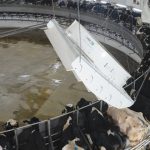
Shenandoah Jerseys, east of Fairplay, remains just one of two dairy farms in the county using robots to milk cows. However, the voluntary milking technology is about to more than double locally. Stoney Hill Farm LLC in the Smithsburg area is seeking permits for a six-robot system to milk a 360-cow herd.
Dairy future
“I think it may be the future of dairy,” Fulton said. “It surprises me how many big herds are going with it.
“I think it’s going to have to be a trend. We have to realize it’s coming, I’m very fortunate that I have the next generation coming in. If you don’t, there’s a lot of expense and change for something short term.”
Fulton is pleased she was in a situation where her daughter, Jess Stiles Hess, and son-in-law, J.R. Hess, wanted to carry on the farm. Then a few years ago she had to decide what to do about an aging milking parlor.
“When we were ready to make this decision, we knew we were in good shape with the feeding aspect of things,” Fulton said. “Comfort for the cows has always been our No. 1 priority, so we looked at systems. And we wanted to make things more flexible for Jess and J.R., and this was a way to do that.
“Our decision was to try to innovate and progress. We were looking at what could make us better and better at business.”
The robots work as part of a voluntary milking system in which the cows enter the robot area when they prefer to be milked. Later this month, the farm will mark two years with the two robots milking the herd of about 100. Fulton said production is up and the cows are thriving.
“We’ve always felt we were doing what we could do on the side of feed and nutrition,” Fulton said. “The only additional advantage would be if they got milked more often to relieve pressure and we’d get a little more production that way. We’ve been happy with that, too.
“And the cows have absolutely been happier. They are comfortable and content all the time. You can tell a happy cow.”
Robots in action
As the top dairy producer, it’s not a surprise that Washington County also leads the state in the number of robots in action. There are a handful of robots in operation in Frederick County, one in Montgomery County and another in Kent County, according to the Maryland Department of Health.
A Washington County dairy farm had robots for milking some years ago, but is no longer in operation. James Campbell started Clearview Acres in the Clear Spring area in 2016, constructing a full robotic dairy operation from the ground up, according to Elmer Weibley, district manager of the Washington County Soil Conservation District.
“The technology has been out there a lot longer than 2016,” said Weibley. “It’s a relatively new development locally. Internationally there’s quite a few of these going in at this point.
“I anticipate this to be a trend. Washington County farmers have always looked for a way to improve the bottom line.”
Weibley’s agency works with farmers on manure storage systems. He expects the 360-cow, six-robot Smithsburg-area robotic dairy plan will successfully move through its approvals.
“I’m very proud of that family to make the commitment from a financial standpoint,” said Weibley. “I’m very proud to have them operating in the county and being willing to do everything just right.”
The robotic milking systems provide the farmer with a different way to manage their cows, something Washington County Extension educator Jeff Semler sees as a good thing for the producer and ultimately the consumer.
“You get a lot of data from the robots,” Semler said. “These robots are set up to monitor milk production, feed intake and many other things.
“Typically we can find a cow that is getting sick about a day and a half earlier than with what we would call clinical science. So we can intervene faster. We can get her over the hump quicker, back to feeling healthy and into production again. We can get her bred quicker because we can monitor her activity and other things. That helps us be able to increase her productive life and her time of being in the barn. There are a lot of things robots are allowing us to do, and again it doesn’t substitute for management, it just gives us more data with which to manage.”
Labor saver
While the cost of robotic milking systems is a major deterrent to its use, the lack of labor availability is a driver.
“One of the biggest issues all farmers have is the labor market — keeping good, solid people trained to milk cows is very difficult,” said Weibley. “There’s just not a lot of young people going into the dairy business. It’s one of those jobs that not a lot of people like doing.
“A robotic system can reduce your time and labor and the amount of effort you have to put into getting and keeping labor.”
Semler saw a robotic milking system for the first time in Holland in 1995.
“The idea is not new,” Semler said. “The idea has just been slow to take root because of the availability in the U.S. of cheap labor, especially in the large dairy states.”
While Washington County is leading the way in Maryland, Semler doesn’t expect to see a boom of robotic milking systems.
“They’re expensive to put in, so the upfront costs are what really deter a decision,” Semler said. “While over the long haul it will pay for itself, because you’re replacing labor.
“The robot doesn’t sleep in. It doesn’t call in sick. It doesn’t miss work. It doesn’t fight with its co-workers. All that may be true, but it still may take 15 years to pay for.”
The actual milking of the cows isn’t the only labor-saving area robotic technology takes care of at Shenandoah Jerseys.
Each cow is automatically fed an individualized ration while it’s being milked by the robot. Every two hours a robot unit operates to push any feed that has been pushed out of reach of the cows back in front of them, providing consistent and constant nutrition.
“We have robot calf feeders for the babies,” Fulton said. “That and the feed pusher made sure we wouldn’t need a hired person.”
Future farmers
“There has to be a future in order to put one (robotic milking system) in, because you’re talking about a long-term investment,” Semler said.
“A lot of small dairy farms in Maryland are typically run by the matriarch or patriarch of the family and probably don’t have a son or daughter who wants to continue, so they’re just milking cows because that’s what they’ve always done and they’re not ready to retire yet. But when they do retire, that will be the end of it.”
The dairy industry has faced challenges in recent years, including consumption, competition and milk prices being paid to producers providing a narrow, if any, profit margin.
“There are certainly slim margins and the consideration of how long do you want to do this,” Semler said. “The other thing is who is the future. A lot of the dairy farmers who have gone out of business in the last 10 to 15 years have done so because there’s nobody to come behind them.”
Fulton is pleased her daughter wanted to continue in dairy.
“We knew we were at a point where we were going to have to put a lot of money into the milking parlor,” Fulton said. “The kids were the first ones that said let’s look into robots.
“We knew we needed an upgrade and they had interest in farming for the future.”
With Stoney Hill, the number of robots milking cows in Washington County will go from five to 11.
“We haven’t heard from a lot of farmers saying they are thinking about it,” Weibley said of the robots. “I think it will continue to expand and it’s the future of the industry in many ways. I don’t see it taking off like wildfire.
“I think it will expand, but I don’t really see a rash of them. Our dairymen in Washington County and across the nation are getting older. There’s some interested from the younger generation, which is encouraging.”
Local staying power
“Our agriculture community really is still the backbone of Washington County and it’s not just for the farm community, but the businesses and industries that support that, too,” Weibley said.
“It also allows Washington County to maintain its rural character, which is a benefit to anyone who lives here — to have the open space to enjoy, aesthetics, to provide for valuable populations of wildlife for hunting and recreational opportunities,” he said. “I think people love open space, and to maintain that, we believe you have to have a strong agriculture base that is committed for the long term.”
Fulton enjoys watching her daughter and son-in-law and their two young boys work the farm and maintains hope for the future of the industry.
“It’s a mixed bag,” Fulton said. “I absolutely love it. Yet there are times that I worry what agriculture is going to be in another 20 years for them.
“There have been little things we’ve had to adjust with going to robots, but all in all we think we’d do it again. They have dreams of doubling the herd and going with another two robots.”























